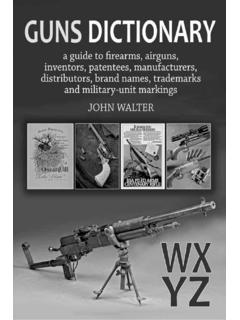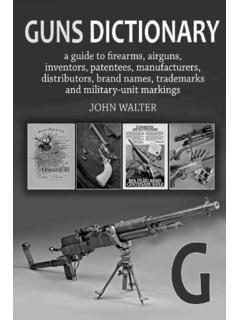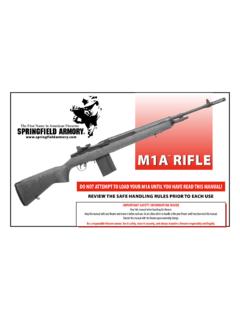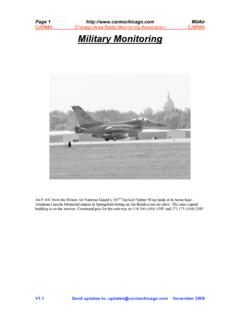Transcription of PAGE L2 - archivingindustry.com
1 GUNS DICTIONARY : PAGE L1 PAGE L2 : GUNS DICTIONARYL above . A mark applied by an inspector working in the Lithgow small arms factory in New South Wales, Australia. See also British military inspectors marks .L cursive, beneath a crown. Found on Bavarian weapons: the mark of Kings Ludwig II (1864 86) and Ludwig III (1913 18). See also Cyphers, imperial and royal .L often cursive, beneath a crown. Found on Belgian weapons: the mark of Kings Leopold II (1865 1909) and Leopold III (1934 50). See also Cyphers, imperial and royal .L Stamped into the woodwork of Long British military rifle butts, which were two inches longer than above crossed rifles and a pistol. A mark found on butt cylinder airguns made by Friedrich Langenhan of Zella St Blasii, Th ringen, Germany, from c.
2 1896 until as L or L Io , beneath a crown. Found on Portuguese weapons: the mark of King Luis I (1861 89). See also Cyphers, imperial and royal .L. This code letter was used on weapons and accessories issued to the Bavarian Leib-Infanterie-Regiment prior to 1918, though it usually appeared as rather than simply . Applied prior to 1918 by the German Feldluftschiffer-Abteilungen, the field airship detachments. Marks take the form , the 15th weapon issued to Abteilung Nr. Coru a, Spanish arms factory: see Mauser . Applied under the provisions of the 1909 German army hand-book, this mark belonged to the Luftschiffer-Ersatz-Abteilung, or supplementary airship (or balloon) detachment.
3 It appears as , for the 15th weapon issued to the 2nd company. See also La France Specialties of San Diego, California, , has specialised in the manufacture of silencers suited to handguns such as the Government Model Fury: see LA Fury , Industrial A small Browning type pocket pistol usually attributed to Orbea Hermanos of Eibar, Guipuzcoa, Spain, though on uncertain grounds; , six Lira This Spanish semi-automatic pistol, the work of Garate, Anitua y Cia of Eibar, was essentially a 1901-pattern Mannlicher in all but two respects: the chambering, for Auto cartridges, and the substitution of a detachable box magazine for the original integral charger-loaded design.
4 A few thousand guns seem to have been made immediately prior to the First World War, but THE DIRECTORY: L LZAU pdated to 4th February 2015 GUNS DICTIONARY : PAGE L3were then superseded by simpler Browning Mignonne A folding .410 shotgun, with a revolver-type grip and a skeleton stock, made in the 1920s by (or perhaps for) Leopold Ancion-Marx of Li Reine, a small airgun: see Carabine la Reine .La Rosa, a Spanish gunmaker/patentee: see La Rosa .La Rosa. A small Spanish-made revolver, customarily a six-shot chambered for the Auto cartridge, with a barrel/cylinder assembly that could be slid forward to load. Essentially similar to the Galand Found on military firearms and accessories.
5 See Lester A. Beardslee .Laballe or La Balle Said to have been used by W. & J. Jeffrey of London, England, on large Gem type butt cylinder airguns sold in the early 1890s. It may signify French or Belgian origin La Balle, The Bullet , perhaps indicating that the guns were either capable of firing conventional cartridges when required, or that they were rifled to fire slugs instead of being smoothbored for Labonte, using an HBL mark, accepted firearms and accessories made for the armed forces by Colt s Patent Fire Arms Mfg Co. They date from 1939. See also arms inspectors marks . or Co.: London Armoury Company ( ). See also James Kerr .Lacey Arthur Lacey; Bridge Street, Stratford upon Avon, Warwick- shire, England.
6 Lacey who also traded as an ironmonger handled sporting guns and ammunition prior to the First World War. Some of the shotgun cartridges apparently bore the names Welcome or Welcome Smokeless .Lachat Jules Lachat; rue de Vernay 50, Saint tienne, France. Listed in 1892 as a ; Li ge, Belgium. A maker of revolvers active in the London. The marks of this English gunmaker have been reported on self cocking pepperboxes dating from the middle of the nineteenth century. A trading style of Lacy & Witton, perhaps?Lacy & Reynolds [ & Company after c. 1852]. Based in Birmingham, this English gunmaker and sword cutler was listed in London in 1850 3, maintaining an office at 21 Great St Helen Edwin Ladmore, a gunmaker trading in Widemarsh Street, Hereford, England (1841 70), is known to have marked sporting guns and self-cocking pepperboxes dating from the middle of the nineteenth Colt A brand name applied unofficially in the early 1870, by Kittredge & Company of Cincinnati, Ohio, , to the.
7 32 New Line Colt Model Similar to the Fourth Model Lord derringer, made by Colt s Patent Fire Arms Mfg Co. in 1959 63, this had gold plating on the frame and barrel, and pearlite grips. See also Thuer s Model A tiny revolver made in Li ge by tablissements A. Lebeaux, c. 1908 Allotted to Heinrich Zeiss (Union Zeiss KG), for use on sights and optical equipment made in a factory in Gostingen/Wartheland, Germany, in 1943 L4 : GUNS DICTIONARYLa Fury or LA Fury Associated with semi-automatic pistols made in Germany by Reck of Lauf bei N rnberg and distributed in the by Hawes Firearms Company of Los Angeles. The mark should be considered as a corruption of Fury ( , , Los Angeles).
8 Lagesa, Lago Arno ld Lahaye; Suhl in Th ringen, Germany. This gunmaking business was trading in 1900 under the proprietorship of Leonhard & Peter Aimo Johannes Lahti (1893 1970) is best known for the 9mm Lahti pistol adopted by the Finnish army prior to the Second World War and then made in larger numbers in Sweden. He also developed submachine-guns (see Suomi ), the Lahti-Saloranta light machine gun described below, the 20mm L-37 aircraft cannon and the 20mm L-39 anti-tank pistol Developed from 1929 onward, this recoil-operated semi-automatic pistol was officially adopted by the Finnish army in 1935. The 9mm Pistooli L-35 was made in small numbers by Valtions Kiv ritehdas (VKT) the state-owned rifle factory, but only nine thousand had been produced in several subvarieties when work stopped in 1954.
9 Excepting one batch of 200, which were subsequently converted, these guns all had accelerators to improve reliability in sub-zero conditions. They also had stock lugs on the butt heel and loaded-chamber indicators on top of the barrel extensions. VKT made 1250 additional guns in 1958, with plain-top barrel extensions. Finnish service pistols have plain serial numbers, but about a thousand failed inspection and were subsequently sold commercially; these have VO number prefixes. Lahti pistols were used in large numbers in Sweden, nearly 84,000 being made by Husqvarna in 1942-6. Issued to the Swedish forces as the Pistol M/40 , owing to the unavailability of the Walther P. 38 and the FN-Browning GP-35 (the first and second choices), the M/40 Lahti was not as successful as its Finnish prototype.
10 It can be identified by its plained contours, especially in the shape of the barrel extension and the trigger guard, and by the crowned h moulded into the grips. Comparatively little has been written about the Lahti in English, though Simply Reliable: Finland s Lahti Pistol in Shooter s Bible, no. 72 (1981), gives a summary of its This 54R light machine-gun, designed by Aimo Lahti and Arvo Saloranta, was adopted by the Finnish army in 1926 and made in small numbers prior to the Winter War of 1939 40; it remained in service until displaced by Soviet weapons in the late 1940s. However, the guns were held in reserve until sufficient 39 m/62 a derivative of the original LS-26 design had been introduced.












